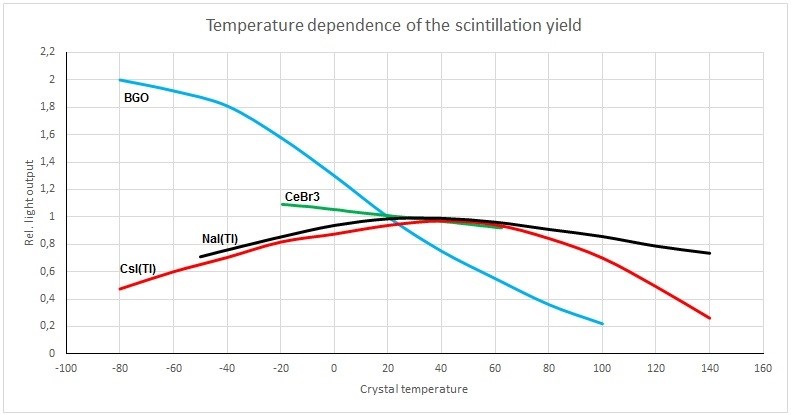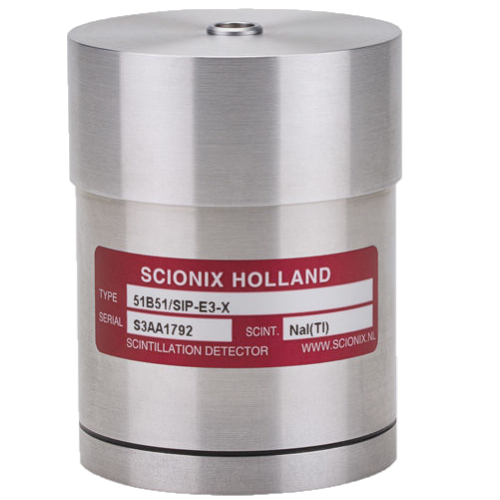Scintillation materials and their most common applications
| Material | Important properties | Major Application |
| NaI(Tl) | Very high light output, good energy resolution | General scintillation counting, Health Physics, environmental monitoring, high temperature use |
| CsI(Tl) | Non-hygroscopic, rugged | Particle and high energy physics, general radiation detection, photo diode readout, |
| CsI(Na) | High light output, rugged | Geophysical, general radiation detection |
| CsI(Undoped) | Fast, non-hygroscopic | Physics (calorimetry) |
| CaF2(Eu) | Low Z, high light outputβ detectors, α/β phoswiches | β detectors, α/β phoswiches |
| Cs2LiYCl6:Ce (CLYC) |
Neutron detection capability High resolution | Nuclear identifiers, Physics |
| LaCl3:Ce(0.9) | Very high light output, very good energy resolution | High resolution scintillation spectroscopy, Health Physics environmental monitoring |
| CeBr3 | Very high light output, very good energy resolution, low background | High resolution spectroscopy, low background applications |
| 6Lil(Eu) | High neutron cross-section, high light output | Thermal neutron detection and spectroscopy |
| LaBr2.85Cl0.15: Ce (LBC) |
Bright, high resolution scintillator (La-138 background) | High resolution gamma spectroscopy |
| Cs2LiLaBr4.8 Cl1.2 Ce (CLLBC) |
High resolution scintillator with neutron capabilities | Physics, security |
| SrI2(Eu) | Bright, high resolution scintillator | High resolution gamma Spectroscopy |
| 6Li-glass | High neutron cross section, non hygroscopic | Physics, security |
| BaF2 | Ultra-fast sub-ns UV emission | Thermal neutral detection |
| YAP(Ce) | High light output, low Z, fast | Positron life time studies,physics, fast timing |
| LYSO | High density and Z, fast | Mhz-X-ray spectroscopy, synchrotron physics |
| BGO | High density and Z | Physics resarch, PETT, High Energy Physics |
| CdWO4 | Very high density, low afterglow. Slow decay times | Particle physics, geophysical research PET, anti- Compton spectrometers. |
| PbWO4 | Fast, high density, low afterglow | DC measurement of x-rays (high intensity), readout with photodiodes, Computerized Tomography (CT) |
| Plastics | Fast, low density and Z high light output | Physics research (calorimetry). General counting, particle and neutron detection. |
NaI(Tl) scintillation crystals are used in a great number of standard applications for detection of γ-radiation because of their high light output and the excellent match of the emission spectrum to the sensitivity of photomultiplier tubes, resulting in a good energy resolution. In addition NaI(Tl) is a relatively inexpensive scintillator. NaI(Tl) crystals show a distinct non proportionality (see below) which results in a limitation of the energy resolution at 662 keV to about 6% FWHM, NaI(Tl) crystals can be grown to large dimensions (400 mm diameter) in ingots of many hundreds of kg. The material can be cut in a great variety of sizes and shapes and cleaved in small diameters.
CsI(Tl) has the advantage that it not really hygroscopic (its surface however is influenced by humidity on the long term),and does not cleave or crack under stress. It is a relatively bright scintillator but its emission is located above 500 nm where PMTs are not that sensitive. However due to this property it can effectively be read out by silicon photodiodes or SiPms. Thanks to its different decay times for charged particles having a different ionizing power, CsI(Tl) crystals are frequently used in arrays or matrices in particle physics research.
CsI(Na) is a hygroscopic high light output rugged scintillator Like CsI(Tl) mainly used for applications where mechanical stability and good energy resolution are required. Below 120 oC it is an alternative to NaI(Tl). CsI(Na) has its emission peaking at 400 nm like NaI(Tl).
Undoped (pure) CsI is an intrinsic scintillator with same density and Z as CsI(Na). It has en emission at approx. 300 nm and since it intensity is strongly thermally quenched at room temperature it is relatively fast (ns decay time). There is a slow component present in this crystal that makes up at least 10% of the total light yield. The emission spectra below show how the emission spectrum of a scintillator can be influenced by its type of activation.
CaF2(Eu) , Europium doped calcium fluoride is a rather old low density scintillation crystal . Thanks to its low Z value it is well suited for the detection of electrons (beta particles) with a high efficiency (low backscatter fraction). CaF2(Eu) is a relatively slow scintillator that is not hygroscopic and inert to many chemicals. It is brittle and cleaves relatively easy.
(6) LiI(Eu) is used for the detection of thermal neutrons via the reaction
The total Q-value of the alpha and the triton is 4.78 MeV. The resulting thermal neutron peak can be found at a Gamma Equivalent Energy larger than 3 MeV. This allows to separate neutron interactions from gamma events (< 2.6 MeV). Since the typical absorption length (90%) of thermal neutrons in 6-LiI(Eu) crystals is only 3 mm the efficiency for gamma rays can be made small. LiI(Eu) crystals are grown up to 25 mm in diameter.
6-Li glass scintillators offer the same possibility as 6LiI(Eu) crystals to detect thermal neutrons. However, The light output is much lower than of LiI(Eu) scintillators and therefore the neutron peaks are relative broad. In addition the scintillation efficiency for the resulting particles is low so that the neutron peak appears at a location of approximately 1.6 MeV in the gamma energy spectrum. 90% of thermal neutrons are absorbed in only1 mm of material.
All 6-Li containing scintillators can also be used for the detection of fast neutrons but the efficiency of the nuclear reaction is smaller.
Barium Fluoride (BaF2) is a non-hygroscopic scintillator with a very fast decay component located at 220 nm. To detect this component, light detectors with quartz windows are used.
Barium fluoride detectors allow fast sub-nanosecond timing for example for positron life time measurements. It is a weak scintillator with a modest energy resolution at 662 keV (typically about 10-12 % FWHM @ 662 keV.
BGO (Bi4Ge3O12) has the extreme high density of 7.13 g/cm3 and has a high Z value which makes these crystals very suited for the detection of natural radioactivity (U, Th, K), for high energy physics applications (high photo fraction) or in compact Compton suppression spectrometers. Since the light output of BGO is modest, the energy resolution is inferior to that of the the standard alkali halides like NaI(Tl) or CsI(Tl).
YAP:Ce (YAlO3:Ce) is a high density (5.5 g/cm3) oxide crystal with a decay time about 10 times shorter than NaI(Tl) (23 ns) It is used in detectors for high count rate (up to several MHz) The non-hygroscopic nature of this material allows the use of thin mylar entrance windows. YAP:Ce can withstand gamma doses up to 104 Gray.
When we observe the physical property table carefully, it is clear that none of presently known scintillation crystals possesses all the ideal characteristics such as high density, fast decay, low cost etc. The choice of a certain scintillation crystal in a radiation detector depends strongly on the application. Questions such as :
1. – What is the energy and type of the radiation to measure ?
2. – What is the expected count rate ?
3. – What are the experimental conditions (temperature, shock) ?
4. – Can the scintillator be grown in the required size ? and
5 – What is its cost ?
are very important in this respect to determine the optimum choice.
We will be happy to assist you in making the best , most cost effective decision for your application.


